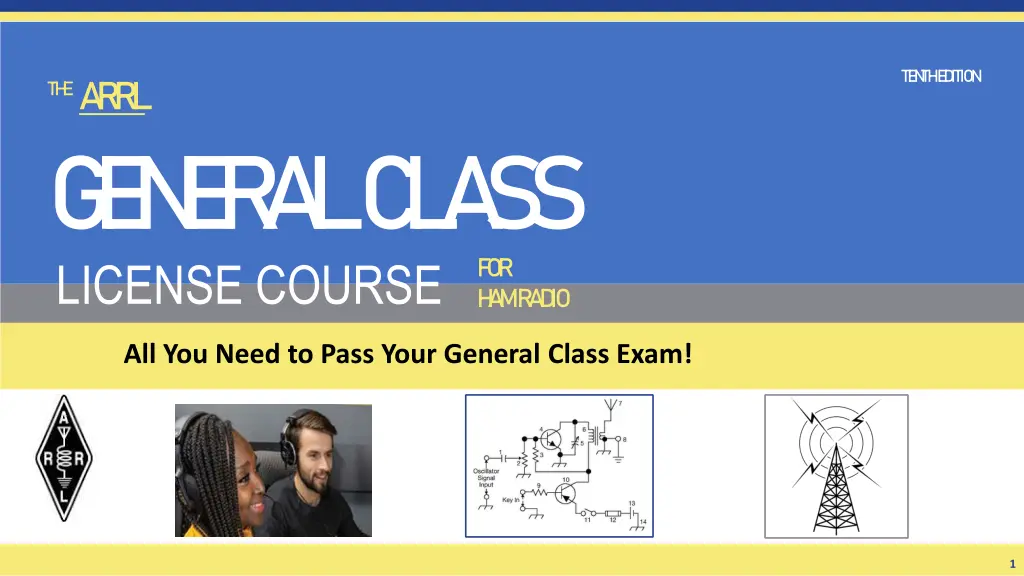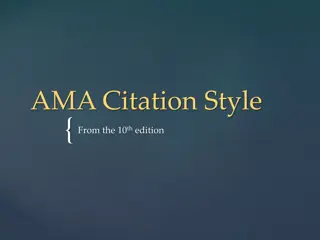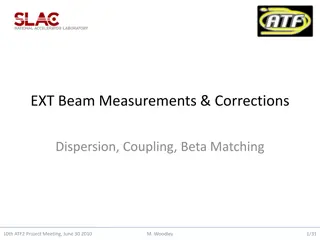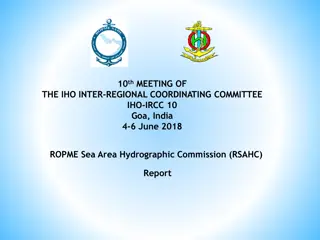
Pass Your General Class Exam with ARRL General Class License Course
"Prepare for your General Class exam with the TE.N.TH.E.D.ITION course by ARRL, covering loop antennas, quad and delta loop beams, and more. Study antennas in Section 7.3 and boost your knowledge to ace the exam. Get all the resources you need to succeed in the ham radio field. Enhance your understanding of antennas and loops to excel in the General Class License Course."
Download Presentation

Please find below an Image/Link to download the presentation.
The content on the website is provided AS IS for your information and personal use only. It may not be sold, licensed, or shared on other websites without obtaining consent from the author. If you encounter any issues during the download, it is possible that the publisher has removed the file from their server.
You are allowed to download the files provided on this website for personal or commercial use, subject to the condition that they are used lawfully. All files are the property of their respective owners.
The content on the website is provided AS IS for your information and personal use only. It may not be sold, licensed, or shared on other websites without obtaining consent from the author.
E N D
Presentation Transcript
TE N TH E D ITION TH EA RRL G E N E R A L C L A SS LICENSE COURSE FOR H A M R A D IO All You Need to Pass Your General Class Exam! 1
Resource & Reference www.arrl.org/shop/Licensing-Education-and-Training 2
Chapter 7 Part 2 of 2 ARRL General Class Antennas Sections 7.3, 7.4, 7.5 Loop Antennas, Specialized Antennas, Feed Lines 3
Section 7.3 Loop Antennas Can be circular, square, triangular or any simple open shape that is not too narrow Feed line can be attached at a break in the loop or a smaller loop can be used to couple RF energy to the main loop A square loop with each leg 1 4 wavelength long is a quad loop Triangular or delta loops are usually symmetrical, each leg 1 3 wavelength long A one-wavelength loop acts electrically like two dipoles connected end-to-end with the open ends brought together Circumference much larger than 1 , current patterns around loop have more than 2 peaks and nulls result is an essentially omnidirectional pattern with the peak angle of radiation somewhat lower than a dipole at the same height 4
Quad and Delta Loop Beams Popular variation of the Yagi beam uses quad loops for elements (quad) Has two or more full-sized loops mounted on a boom Quad or delta loop beam driven elements are approximately 1 in circumference and operate on the same principles of re-radiation and phase shift as does the Yagi The driven element of a quad is about 1 4 per side and of a symmetrical delta loop about 1 3 per side Quad and delta loop reflectors are about 5% longer in circumference than the driven element, and the directors about 5% shorter Front-to-back ratio is generally better for the Yagi 5
Fig. 7.10 1-Wavelength Loop Antenna Direction of maximum signal is broadside to the plane of the loop, whether round, quad or delta. Orienting the loop vertically aims the maximum signal toward the horizon (good for DX). 6
Small Loops When the circumference of the loop becomes less than 1 3 , the current in the loop becomes relatively uniform all the way around the loop Image in Fig. 7-10 a small loop rotated 90 degrees from the loop in the figure Causes radiation pattern to develop sharp nulls broadside to the plane of the loop In wide use as receiving antennas and portable or low- profile transmitting antennas The sharp null broadside to the loop makes them effective for direction-finding Typical small loop portable HF antenna 7
Halo Antennas Dipole bent into a circle or square (the squalo ) with the ends separated by a small gap Not a continuous loop, but often viewed as a 1 2 loop Usually mounted horizontally so they produce an omnidirectional pattern with the horizontal polarization preferred for VHF weak-signal operation Halos for 6 and 2 meters can be mounted on a vehicle for mobile operation 8
In which direction is the maximum radiation from a VHF/UHF halo antenna? A. Broadside to the plane of the halo B. Opposite the feed point C. Omnidirectional in the plane of the halo D. On the same side as the feed point G9D03 (C) Page 7-16 10
In which direction or directions does an electrically small loop (less than 1 10 wavelength in circumference) have nulls in its radiation pattern? A. In the plane of the loop B. Broadside to the loop C. Broadside and in the plane of the loop D. Electrically small loops are omnidirectional G9D10 (B) Page 7-15 11
Section 7.4: Specialized Antennas Random Wire Antennas Not always practical to have a 1 2 or 1 4 long resonant antenna (portable) A random wire antenna can be used Connected directly to the output of the transmitter (or tuner) without a feed line May result in significant RF currents and voltages on the station equipment (RF burns) Can give excellent results on any band for which the transmitter or tuner can accept the feed point impedance 12
Stacked Antennas Stacking antennas (vertically or horizontally) results in more gain (see Fig 7.14) As more and more directors are added, the beamwidth of the main lobe (angle between points on the main lobe at which gain is 3 dB less than maximum) narrows Vertically stacking antennas increases gain and narrows the elevation beamwidth Most vertical stacks, with the antennas directly above each other, space the antennas about /2 apart. Spaced /2 apart, the additional gain for a vertical stack of two horizontally-polarized beams is about 3 dB. 13
Fig. 7.14: Stacked Antennas Stacking antennas produces more gain in a main lobe that is carefully controlled. At A, two Yagis are stacked vertically on the same mast. 14
Log Periodic Antennas (or Logs) See Fig. 7.15 TV antennas are often log periodics Log refers to logarithmic & periodic means the spacing of the elements along the boom The length and the spacing of the elements increases logarithmically from one end to the other Designed to have a consistent radiation pattern and low SWR over a wide frequency bandwidth (as much as 10:1) Meaning the log periodic can be used over several bands Not as much gain or front-to-back ratio as a Yagi antenna 15
Fig. 7.15: Log Periodic Antenna The log periodic dipole array (LPDA) consists of dipoles fed by a common feed line that alternates polarity between elements. Traditional TV antennas sweep the elements slightly forward. 16
Beverage Antennas Invented by Harold Beverage (see Fig 7.16) Designed not to have high gain, but to reject noise and interfering signals that are not from the desired direction Result is lower signal strength but a better signal-to-noise ratio Referred to as a traveling wave antenna Consists of a long, low wire (usually less than 20 feet high) aligned with the preferred signal direction Used exclusively for directional receiving on MF and lower HF bands (40 meters and longer wavelengths) Has high ground losses and is too inefficient for use as a transmitting antenna 17
Fig. 7.16: Beverage Antenna Antenna Design Radiation Pattern Signals arriving from the direction of the terminating resistor induce a traveling voltage wave along the wire transferred to the feed line at the feed point. Signals arriving from other directions are either absorbed by the terminating resistor or do not induce voltage waves in the antenna. 18
Multiband Antennas What hams generally mean by multiband antenna is a design that reconfigures itself electrically for each band of operation Most basic multiband antenna trap dipole (See Fig 7.17) Each trap is a parallel LC circuit At resonance acts like an open circuit, below resonance like an inductor, and above resonance like a capacitor At lower frequencies, the traps add inductance to the antenna, making the antenna look electrically longer At higher frequencies, the capacitance electrically shortens the antenna 19
Fig 7.17: Traps Traps are parallel LC circuits. They may be made from discrete inductors and capacitors or may use coaxial cable or metal sleeves. The traps act like open circuits at their resonant frequency, causing different sections of the antenna to be active on different bands. This drawing shows a trap antenna that works on 10, 15, and 20 meters. 20
Trap Dipoles (cont.) The lowest frequency of operation the antenna acts like a regular dipole, shortened by the inductance of the trap Yagis can also use traps to work on several bands 3-element tribander Yagi with traps in the elements works well on 20, 15 & 10 meters Trap drawbacks Because it works on multiple bands, it radiates harmonics and spurious signals (transmitter operator s responsibility to be sure those signals are not generated) Trap losses reduce the efficiency of the antenna Will not radiate as well as a full-sized antenna 21
What is a characteristic of a random-wire HF antenna connected directly to the transmitter? A. It must be longer than 1 wavelength B. Station equipment may carry significant RF current C. It produces only vertically polarized radiation D. It is more effective on the lower HF bands than on the higher bands G9B01 (B) Page 7-16 23
In free space, how does the gain of two three-element, horizontally polarized Yagi antennas spaced vertically 1 2 wavelength apart typically compare to the gain of a single three-element Yagi? A. Approximately 1.5 dB higher B. Approximately 3 dB higher C. Approximately 6 dB higher D. Approximately 9 dB higher G9C09 (B) Page 7-17 24
What is the primary function of antenna traps? A. To enable multiband operation B. To notch spurious frequencies C. To provide balanced feed point impedance D. To prevent out-of-band operation G9D04 (A) Page 7-19 25
What is an advantage of vertical stacking of horizontally polarized Yagi antennas? A. It allows quick selection of vertical or horizontal polarization B. It allows simultaneous vertical and horizontal polarization C. It narrows the main lobe in azimuth D. It narrows the main lobe in elevation G9D05 (D) Page 7-17 26
Which of the following is an advantage of a log periodic antenna? A. Wide bandwidth B. Higher gain per element than a Yagi antenna C. Harmonic suppression D. Polarization diversity G9D06 (A) Page 7-17 27
Which of the following describes a log-periodic antenna? A. Element length and spacing vary logarithmically along the boom B. Impedance varies periodically as a function of frequency C. Gain varies logarithmically as a function of frequency D. SWR varies periodically as a function of boom length G9D07 (A) Page 7-17 28
What is the primary use of a Beverage antenna? A. Directional receiving for low HF bands B. Directional transmitting for low HF bands C. Portable direction finding at higher HF frequencies D. Portable direction finding at lower HF frequencies G9D09 (A) Page 7-19 29
Which of the following is a disadvantage of multiband antennas? A. They present low impedance on all design frequencies B. They must be used with an antenna tuner C. They must be fed with open wire line D. They have poor harmonic rejection G9D11 (D) Page 7-19 30
Section 7.5 Feed Lines / Characteristic Impedance Balanced feed lines consist of two parallel conductors separated by insulating material in the form of strips or spacers Have different characteristic impedances (Z0) that characterize how electromagnetic energy is carried by the feed line (different from resistance) For parallel-conductor feed lines, the radius of the conductors and the distance between them determine Z0 Most common type is window line Typical impedance for window line is 450 (some as low as 400 ) Most common characteristic impedances for coaxial feed lines used by amateurs are 50 and 75 31
Fig 7.18 Some common types feed lines used by amateurs. Parallel conductor line (A, B, C) has two parallel conductors separated by insulation (dielectric). Coaxial cable (D, E, F, G) or coax has a center conductor surrounded by insulation. The center conductor may be made from stranded or solid wire. The second conductor, called the shield, covers the insulation and is in turn covered by the plastic outer jacket. The shield may be made from braid, or from solid aluminum or copper. 32
Forward & Reflected Power & SWR A feed line transfers all of its power to an antenna when the antenna and feed line impedances are matched If impedances don t match, some of the power is reflected by antenna Forward power: power traveling toward the antenna Reflected power: power reflected by the antenna Power in a feed line is reflected at any point at which the impedance of the feed line changes Can be at an antenna, connector, or from a different type of feed line 33
SWR The waves carrying forward power and reflected power form stationary patterns inside the feed line. These are called STANDING waves. The ratio of the peak voltage in the standing wave to the minimum voltage is called the standing wave ratio (SWR) Measures how well antenna and feed line impedances are matched 1:1 is a perfect match none of the power is reflected SWR = infinity ( ) indicates that all the power was reflected SWR is always greater than 1:1 (for example, 3:1 and not 1:3) 34
Calculating SWR SWR is equal to the ratio of the higher of antenna feed point impedance or feed line characteristic impedance to the lower. Example: What is the SWR in a 50- feed line connected to a 200- load? 200 50 = 4 = 4 1 ??? = Example: What is the SWR in a 50- feed line connected to a 10- load? 50 10 = 5 = 5 1 ??? = 35
SWR (cont.) Can be measured anywhere along feed line Most commonly measured at connection to transmitter SWR is measured by an SWR Meter (also called Bridge) Transmitting equipment is designed to work at full power with an SWR at the input to the feed line of 2:1 or lower Antennas that are much too short or too long will not work well and will have extreme feed point impedances, causing high SWR 36
Impedance Matching Matching feed line and load (antenna) impedances eliminates standing waves from reflected power and maximizes power delivered to the load (but, not always practical the impedance matching is more often done at the transmitter end of the feed line) Devices used to reduce SWR are called: impedance matcher, transmatch, antenna coupler, and antenna tuner Tuners do NOT tune the antenna at all only changes impedance of the antenna system at end of feed line to match that of transmitter In other words, an antenna tuner increases the power transfer from the transmitter to the feed line 37
Impedance Matching (cont.) Devices constructed from inductors and capacitors that are adjustable by the operator T circuit can match a wide range of impedances at the feed line connection to 50 that matches transmitter output impedance It is important to remember that the SWR in the feed line between the impedance matching device and the antenna does not change the device just changes the load going to the transmitter SWR in feed line stays the same 38
Fig. 7.19: T Network Installed at the transmitter end of the feed line, a T network is designed to be used with unbalanced, coaxial feed lines. This circuit uses two variable capacitors and one variable inductor. To use balanced feed lines, such as window line, the output of a T network can be inductively coupled to the output so that neither of the feed line conductors is connected to ground. 39
Feed Line Loss Feed lines dissipate a little of the energy they carry as heat (called attenuation or loss) Loss is measured in dB per unit of length, usually dB/100 feet Loss increases with frequency for all types of feed lines The smaller the cable diameter, the higher the loss Increasing SWR in a feed line also increases the total loss The higher the feed line loss, the lower the measured SWR will be at the input to the line 40
What is the purpose of an antenna tuner? A. Reduce the SWR in the feed line to the antenna B. Reduce the power dissipation in the feedline to the antenna C. Increase power transfer from the transmitter to the feed line D. All these choices are correct G4A06 (C) Page 7-22 42
Which of the following factors determine the characteristic impedance of a parallel conductor feed line? A. The distance between the centers of the conductors and the radius of the conductors B. The distance between the centers of the conductors and the length of the line C. The radius of the conductors and the frequency of the signal D. The frequency of the signal and the length of the line G9A01 (A) Page 7-20 43
What is the relationship between high standing wave ratio (SWR) and transmission line loss? A. There is no relationship between transmission line loss and SWR B. High SWR increases loss in a lossy transmission line C. High SWR makes it difficult to measure transmission line loss D. High SWR reduces the relative effect of transmission line loss G9A02 (B) Page 7-23 44
What is the nominal characteristic impedance of window line transmission line? A. 50 ohms B. 75 ohms C. 100 ohms D. 450 ohms G9A03 (D) Page 7-21 45
What causes reflected power at an antennas feed point? A. Operating an antenna at its resonant frequency B. Using more transmitter power than the antenna can handle C. A difference between feed-line impedance and antenna feed-point impedance D. Feeding the antenna with unbalanced feed line G9A04 (C) Page 7-21 46
How does the attenuation of coaxial cable change with increasing frequency? A. Attenuation is independent of frequency B. Attenuation increases C. Attenuation decreases D. Attenuation follows Marconi s Law of Attenuation G9A05 (B) Page 7-23 47
In what units is RF feed line loss usually expressed? A. Ohms per 1,000 feet B. Decibels per 1,000 feet C. Ohms per 100 feet D. Decibels per 100 feet G9A06 (D) Page 7-23 48
What must be done to prevent standing waves on a feed line connected to an antenna? A. The antenna feed point must be at DC ground potential B. The feed line must be an odd number of electrical quarter wavelengths long C. The feed line must be an even number of physical half wavelengths long D. The antenna feed point impedance must be matched to the characteristic impedance of the feed line G9A07 (D) Page 7-22 49
If the SWR on an antenna feed line is 5:1, and a matching network at the transmitter end of the feed line is adjusted to present a 1:1 SWR to the transmitter, what is the resulting SWR on the feed line? A. 1 to 1 B. 5 to 1 C. Between 1 to 1 and 5 to 1 depending on the characteristic impedance of the line D. Between 1 to 1 and 5 to 1 depending on the reflected power at the transmitter G9A08 (B) Page 7-23 50






















